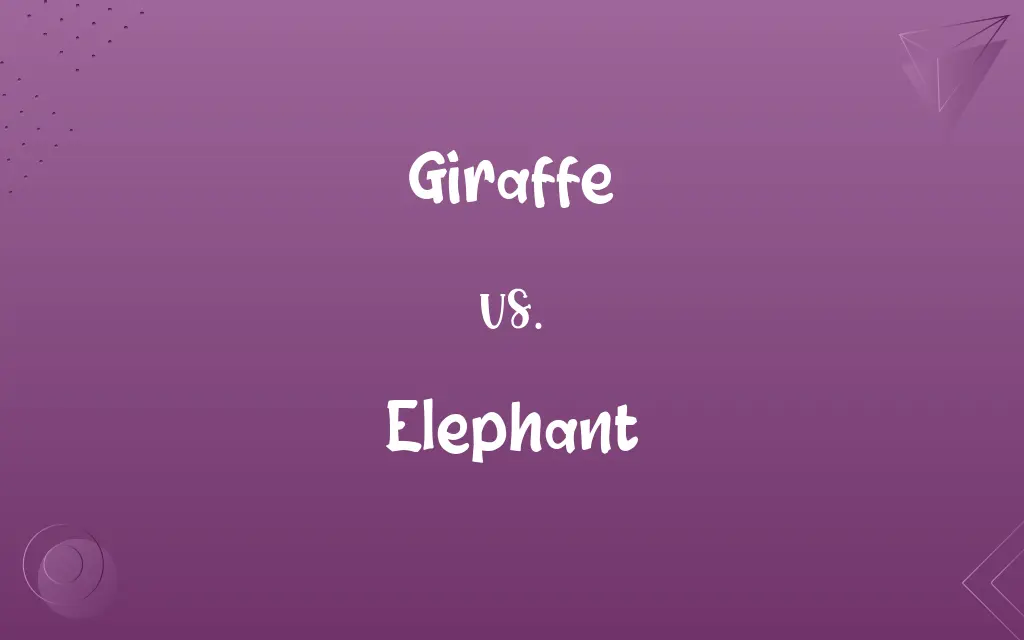Giraffe vs. Elephant: Know the Difference

By Shumaila Saeed & Hifza Nasir || Updated on March 4, 2024
Giraffes are the tallest land animals, relying on height for foliage, whereas elephants are the largest, using strength to manipulate their environment.

Key Differences
Giraffes are renowned for their remarkable height, which can reach up to 18 feet, allowing them to access leaves and branches higher than other animals can reach. This height provides a significant advantage in habitats where food sources are competitive. Elephants, on the other hand, are the largest land animals, with adult males weighing up to 14,000 pounds. Their size and strength enable them to alter their environment, such as uprooting trees or creating waterholes, which can benefit other species as well.
Hifza Nasir
Mar 04, 2024
While the giraffe's long neck is iconic for feeding on treetops in the African savannas, it also plays a crucial role in thermoregulation and surveillance for predators. Elephants, however, use their trunk, a unique and versatile organ, for feeding, drinking, and social interactions, demonstrating a remarkable adaptation to their environment.
Shumaila Saeed
Mar 04, 2024
Giraffes have a specialized cardiovascular system with a powerful heart to pump blood up their long necks to the brain, showcasing an evolutionary adaptation to their tall stature. Elephants have adapted to their massive size with strong, pillar-like legs to support their weight and a highly efficient cooling system, including large ears that help regulate body temperature.
Shumaila Saeed
Mar 04, 2024
Reproduction and social behavior in giraffes are characterized by their loose social structures, where females form groups for rearing young, while males often roam solo or in bachelor groups. Elephants are known for their complex social structures, living in matriarchal families led by the oldest female, emphasizing the importance of social bonds and cooperation in their survival and nurturing of the young.
Hifza Nasir
Mar 04, 2024
Both giraffes and elephants face significant threats from habitat loss and poaching. Their survival depends on conservation efforts that address the challenges unique to each species, highlighting the importance of biodiversity and ecosystem balance.
Dua Fatima
Mar 04, 2024
ADVERTISEMENT
Comparison Chart
Feeding
Browsers, eating leaves and branches
Herbivores, eating a variety of vegetation
Hifza Nasir
Mar 04, 2024
ADVERTISEMENT
Adaptations
Powerful heart, long neck for feeding and surveillance
Versatile trunk, large ears for cooling
Dua Fatima
Mar 04, 2024
Reproduction
Calves are born after 15 months
Calves are born after 22 months
Shumaila Saeed
Mar 04, 2024
Conservation Status
Vulnerable to habitat loss and poaching
Endangered in certain areas, facing similar threats
Dua Fatima
Mar 04, 2024
Giraffe and Elephant Definitions
Giraffe
Browsers, primarily feeding on foliage.
A group of giraffes were seen browsing the leaves of acacia trees.
Shumaila Saeed
Mar 04, 2024
Elephant
Known for their complex social structures and intelligence.
The elephant herd was led by the oldest and wisest female.
Shumaila Saeed
Mar 04, 2024
ADVERTISEMENT
Giraffe
Have a unique walking gait, moving both right legs then both left legs.
The giraffe's elegant stride is a result of its unique gait.
Hifza Nasir
Mar 04, 2024
Elephant
Inhabit various ecosystems in Africa and Asia.
Elephants play a crucial role in their ecosystems, shaping the landscape.
Hifza Nasir
Mar 04, 2024
Giraffe
Vulnerable due to habitat loss and poaching.
Conservation efforts are crucial for the survival of giraffes.
Hifza Nasir
Mar 04, 2024
Elephant
The largest land animal, known for its trunk and tusks.
The elephant used its trunk to gather food and water.
Dua Fatima
Mar 04, 2024
Giraffe
A tall mammal known for its long neck and legs.
The giraffe stretched its neck to reach the topmost leaves of the tree.
Dua Fatima
Mar 04, 2024
Elephant
Endangered in some regions, facing threats from poaching and habitat loss.
Protecting elephants is essential for their future survival.
Dua Fatima
Mar 04, 2024
Giraffe
Native to African savannas and woodlands.
Giraffes roam the open landscapes of Africa, blending into the tall grasses.
Shumaila Saeed
Mar 04, 2024
Elephant
Herbivores with a diverse diet.
Elephants can consume up to 300 pounds of vegetation daily.
Shumaila Saeed
Mar 04, 2024
Giraffe
An African ruminant mammal (Giraffa camelopardalis) having a very long neck and legs, a tan coat with orange-brown to black blotches, and short horns. It is the tallest land animal, often reaching a height of 5 meters (16 feet).
Shumaila Saeed
Oct 19, 2023
Elephant
Any of several very large herbivorous mammals of the family Elephantidae native to Africa, South Asia, and Southeast Asia, having thick, almost hairless skin, a long, flexible, prehensile trunk, upper incisors forming long curved tusks of ivory, and, in the African species, large fan-shaped ears.
Shumaila Saeed
Oct 19, 2023
Giraffe
Tallest living quadruped; having a spotted coat and small horns and very long neck and legs; of savannahs of tropical Africa
Shumaila Saeed
Oct 19, 2023
Elephant
A mammal of the order Proboscidea, having a trunk, and two large ivory tusks jutting from the upper jaw.
Shumaila Saeed
Oct 19, 2023
Repeatedly Asked Queries
How do giraffes and elephants socialize?
Giraffes have a loose social structure, often forming groups for rearing young, while elephants live in close-knit matriarchal family groups with complex social interactions.
Dua Fatima
Mar 04, 2024
How do giraffes and elephants use their physical features to feed?
Giraffes use their long necks to access leaves and branches high up in trees, while elephants use their trunks to pull down branches, pick up food, and dig for water sources.
Shumaila Saeed
Mar 04, 2024
What distinguishes a giraffe's habitat from an elephant's?
Giraffes primarily inhabit savannas and woodlands in Africa, focusing on areas with abundant foliage, while elephants are found in a variety of habitats, including forests, savannas, and deserts in both Africa and Asia.
Hifza Nasir
Mar 04, 2024
How long do giraffes and elephants live?
Giraffes can live up to 25 years in the wild, while elephants can live up to 60-70 years, depending on the species and environmental conditions.
Hifza Nasir
Mar 04, 2024
Can giraffes and elephants live in the same habitat?
Yes, giraffes and elephants can share habitats, such as African savannas, where their feeding habits and movements complement each other.
Shumaila Saeed
Mar 04, 2024
What role do giraffes and elephants play in their ecosystems?
Giraffes help in seed dispersal and maintaining the foliage at higher levels, while elephants are known as ecosystem engineers, altering the landscape in ways that benefit other species.
Dua Fatima
Mar 04, 2024
How do giraffe and elephant reproductive strategies differ?
Giraffes have a gestation period of about 15 months, leading to the birth of a single calf, while elephants have a longer gestation period of about 22 months, also typically resulting in one offspring.
Shumaila Saeed
Mar 04, 2024
What are the conservation statuses of giraffes and elephants?
Giraffes are classified as vulnerable, mainly due to habitat loss and poaching, whereas elephants are endangered in certain areas, facing similar threats.
Shumaila Saeed
Mar 04, 2024
Why are giraffes' and elephants' sizes advantageous?
Giraffes' height allows them to reach food sources unavailable to other animals, while elephants' size provides them strength to manipulate their environment for food, water, and shelter.
Dua Fatima
Mar 04, 2024
What threats do giraffes and elephants face?
Both species face significant threats from habitat destruction, human-wildlife conflict, and poaching, with elephants specifically targeted for their ivory tusks.
Hifza Nasir
Mar 04, 2024
Share this page
Link for your blog / website
HTML
Link to share via messenger
About Author
Written by
Shumaila SaeedShumaila Saeed, an expert content creator with 6 years of experience, specializes in distilling complex topics into easily digestible comparisons, shining a light on the nuances that both inform and educate readers with clarity and accuracy.
Co-written by
Hifza Nasir








































































